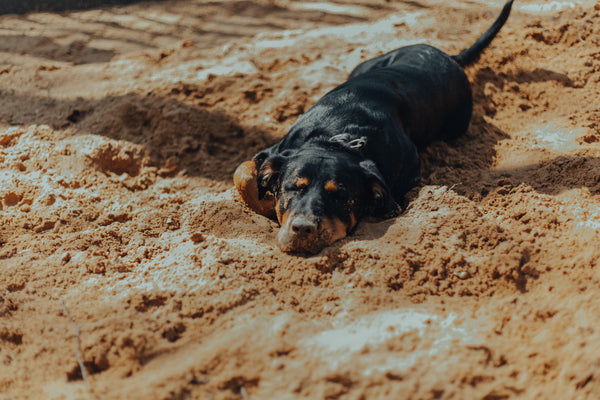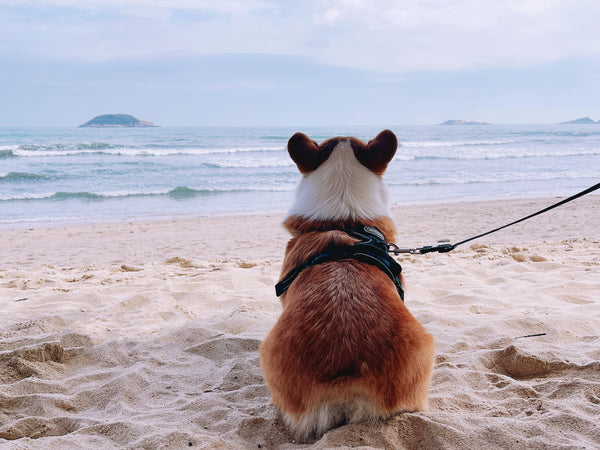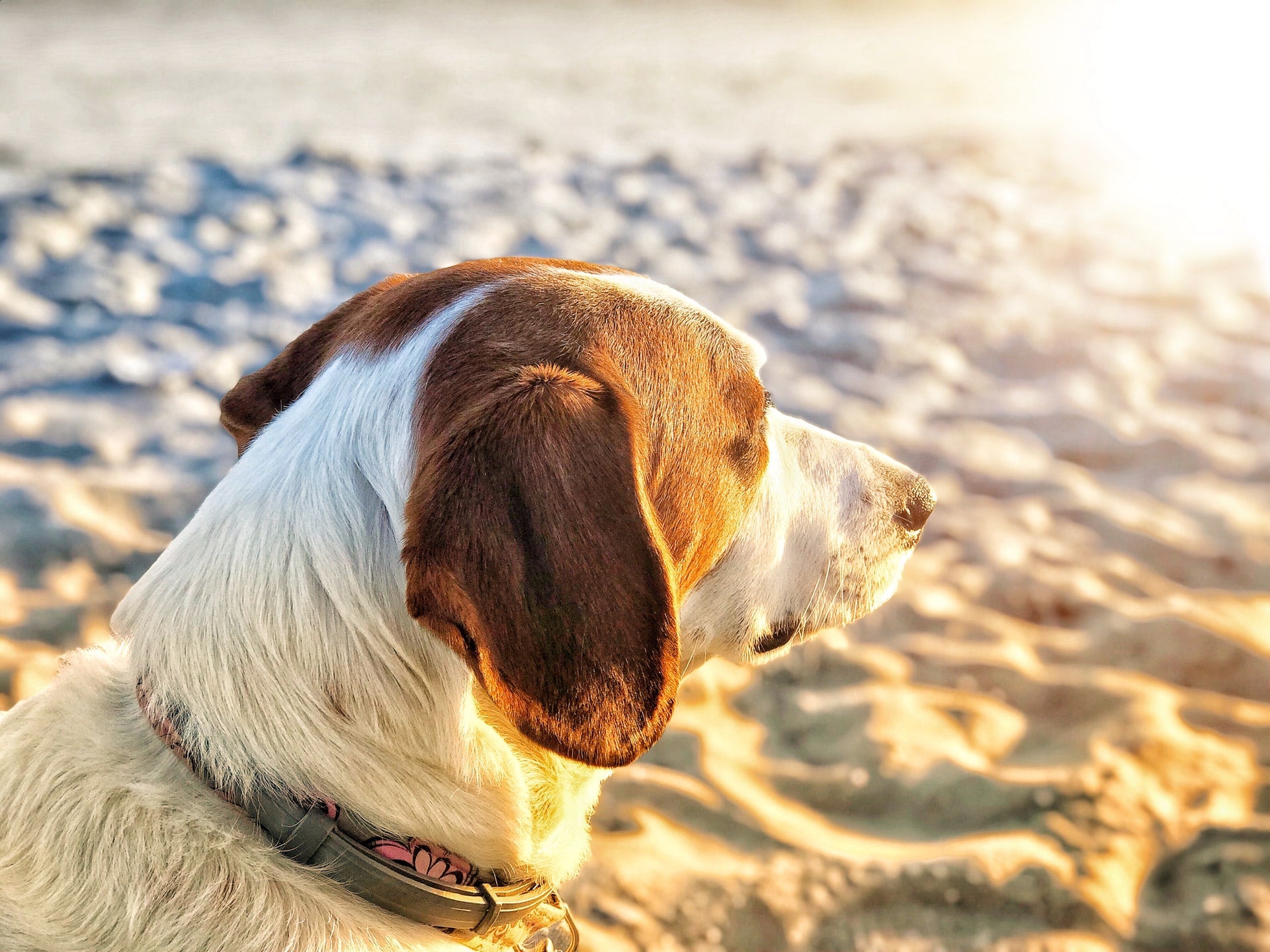Did you know that dogs need sunscreen?
Protecting your dog from the sun is essential for their health and well-being. Dogs are just as susceptible to sunburn, skin cancer, and other health problems caused by UVB rays as humans are.
On top of that- not only can the sun cause skin damage, but it can also dehydrate your dog and lead to other health issues.
By protecting your dog from the sun's UV rays by using dog sunscreen, you can ensure your pooch stays healthy and happy this summer.
In this article, we'll talk about the importance of sun protection for your four-legged friend and how to protect your pup by using sunscreen specifically intended for dogs.

The Basics of Sunscreen for Dogs
What Type of Sunscreen Should You Use on Your Dog?
It's important to choose a sunscreen specifically designed for dogs when applying it to your pup. Human sunscreen often contains ingredients such as oxybenzone or avobenzone, which can cause skin irritation, allergic reactions, or even serious illness in pets if ingested.
Look for sunscreens labeled "for use on dogs." Most dog sunscreens avoid chemicals that are toxic to dogs and are FDA-approved.
How Do Dogs Get Sunburned?
Dogs can get sunburned in much the same way as humans. Areas of a dog's skin that aren't covered by fur—such as the dog's nose and ears—are especially vulnerable to sun damage.
Furthermore, dogs with light-colored fur, thin coats, or short hair are more likely to get sunburned. It's important to be mindful of how long your dog is in direct sunlight and make sure to provide shade or other forms of protection.
What Does Sunburn Look Like on a Dog?
Sunburn on a dog can appear as red, irritated skin, with possible swelling or crusty patches. Sunburned areas may also be painful and sensitive to the touch.
If you suspect your pup has sunburn, it's best to take them to the vet for a check-up and proper treatment.
Natural vs. Chemical Sunscreen
There are two main types of sunscreen: chemical and natural (sometimes called “mineral”). Chemical sunscreens contain active ingredients such as oxybenzone or avobenzone. which work by absorbing UV radiation. However, these ingredients can be harsh on your pup's skin and may cause irritation or allergic reactions.
Natural sunscreens, on the other hand, use physical blockers including titanium dioxide and zinc oxide to form a barrier on the skin that reflects UV radiation away from your pup. These natural sunscreens are generally gentler and safer for dogs.
Sun Protection Factor (SPF) in Dog's Sunscreen
When choosing a type of sunscreen for your pup, it's important to consider the Sun Protection Factor (SPF). The higher the SPF, the more protection your dog's body will get from the sun. Sunscreens with an SPF of 15 offer moderate protection, while those with an SPF of 30 or above provide strong protection against UV radiation.
It is also important to check the expiration date for any sunscreen you use. Sunscreen should be replaced regularly to ensure it is still effective in protecting your pup against the sun's harmful UV rays.

Waterproofing and Sweat Resistance
If you plan on taking your pup swimming or engaging in activities that involve heavy sweating, it's important to choose a sunscreen that is waterproof and sweat-resistant. Sunscreen labeled as "waterproof" will last for up to 80 minutes in water, while those labeled as "sweat-resistant" will last for 40 minutes before needing to be reapplied.
Make sure to check the label on your sunscreen for specific instructions, as some may need to be reapplied more often than others.
Sunscreen Precautions
Remember to always read and follow the instructions on the product label when applying sunscreen to your pup. Some sunscreens may contain ingredients that irritate some dogs, so it's important regularly check for signs of skin irritation or other concerning symptoms after they have spent time in the sun.
How Can I Tell If a Particular Sunscreen Is Irritating My Dog?
Signs that your dog may be having an adverse reaction to sunscreen include redness, itchiness, rashes, hives, and swelling.
If you notice any signs of skin irritation or other concerning symptoms after applying sunscreen to your pup, stop using the product and take them to the vet for a check-up.
How Do I Apply Sunscreen on My Dog?
1.) Gently Brush Your Dog's Coat Before Applying Sunscreen
Gently brushing your dog's fur in the opposite direction of hair growth is a key step in preparing to apply sunscreen. Doing this will help the sunscreen penetrate more deeply and evenly into the fur, helping it protect better against UV rays.
To do this, start at your pup's head and brush its entire body with long strokes in one direction. Be sure to wait until your pup is calm and relaxed before you start brushing, as this can be a stressful experience for some dogs.
If your dog experiences high stress while getting brushed, consider giving them a few calming chews before brushing them so you can ensure that it’s a smoother experience for both of you.
2.) Apply Sunscreen to Your Dog's Body
Once your pup is brushed, you can begin applying the sunscreen. Start with a small amount and gently rub it into each area you want to cover, avoiding sensitive areas such as the eyes, nose, mouth, and ears.
Take time to cover each area thoroughly and ensure the sunscreen is worked into the fur down to the skin. You may want to use a comb or brush after applying the sunscreen to spread it out more evenly.
Once you have finished applying sunscreen, let your pup rest for at least five minutes before letting them go back outside or into the pool.

3.) Reapply As Needed
Sunscreen should be applied about every two hours, or more often if your dog is swimming or heavily active outdoors. However, you should not apply sunscreen more than 3-4 times a day.
Remember to always consult with your vet if you are unsure about the amount or frequency of applying sunscreen for your pup.
What Else Can I Do to Protect My Dog From the Sun?
In addition to using sunscreen on your pup, there are a few other things you can do to make sure they're staying safe in the sun:
- Ensure your pup has access to plenty of water throughout the day and take regular breaks in shady areas.
- Avoid walking your dog during peak hours of sunlight (i.e. when the sun is at its strongest).
- Invest in pet-friendly clothing, such as a doggy t-shirt or a bandana, to cover your pup's head and neck.
- Use UV-ray protective window shades for cars if you're going on a more extended road trip with your pup.
- Look for products designed specifically for dogs, such as cooling mats or cooling vests.
- Consider getting a dog pool or sprinkler for your pup to play in during warmer months.
Benefits of Using Sun-Protective Clothing or Accessories
In addition to using sunscreen, you can also provide extra sun protection for your pup by dressing them in sun-protective clothing and accessories.
Sun protective clothing is designed with special features such as UPF (Ultraviolet Protection Factor) fabric that blocks out both UVA and UVB rays from the sun, keeping your pup safe while out in the elements.
Examples of Sun-Protective Apparel for Dogs
Examples of sun-protective apparel for dogs include UV-blocking collars, hats, sun shirts, t-shirts, and swimsuits. These items can help to reduce the amount of direct sunlight that reaches your pup's skin and keep them from overheating.
While no sunscreen or clothing is 100% effective in protecting against the sun's rays, using these items in conjunction with sunscreen is a great way to keep your pup safe and healthy during the hot summer months.
What Are Signs That My Dog Is Suffering From Sunburn or Overheating?
Dogs may show several signs that they are suffering from sunburn or overheating, including:
- Excessive panting
- Reddened skin or fur, especially around the ears and nose
- Crusty patches on the nose or paws
- Extremely dry skin
- Irritability or fatigue
- Loss of appetite

What Should I Do If My Dog Gets Sunburned?
If you notice any areas of your pup's skin that are red or irritated, it is important to take them to the vet right away. Sunburn can be very painful for dogs and can also lead to serious medical issues if left untreated.
Your vet may recommend an ointment or cream to help soothe the burned area and promote healing. In some cases, they may even prescribe antibiotics to help prevent infection. One preventative measure is creating a consistent vitamin routine that incorporates supplements to support skin health, such as omega-3s.
It is also important to limit your pup's sun exposure until their burn has healed completely. This will ensure that the area does not become further irritated or burned during recovery.
All in all...
Protecting your dog from harmful UV rays is an important part of keeping them safe and healthy. Sunscreen, sun-protective clothing and accessories, and providing breaks from the sun are all important steps in making sure that your pup is happy and healthy this summer!
By following the tips outlined above, you can help ensure that your pup gets the protection they need while enjoying outdoor activities and adventures. You should also always consult with a vet before using sunscreen on your pup.













